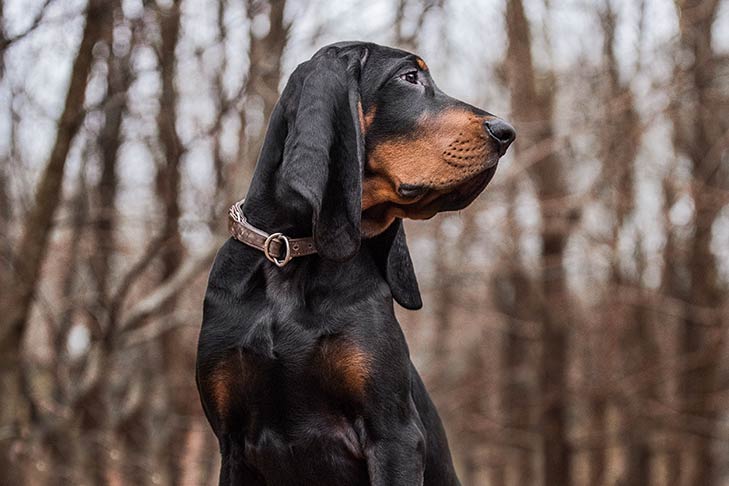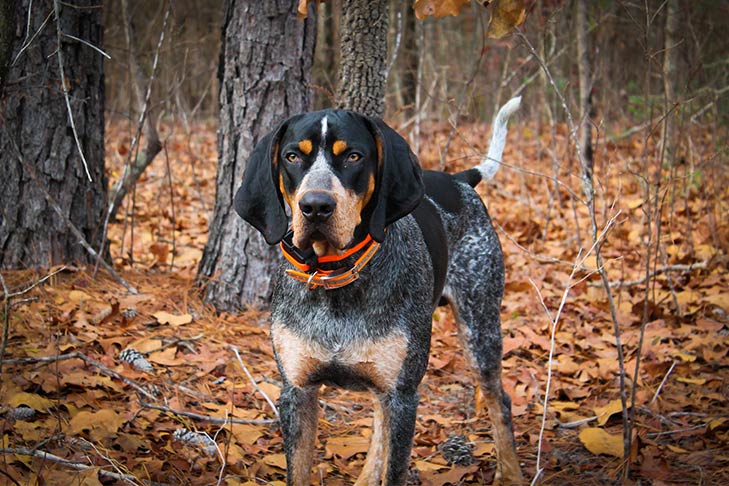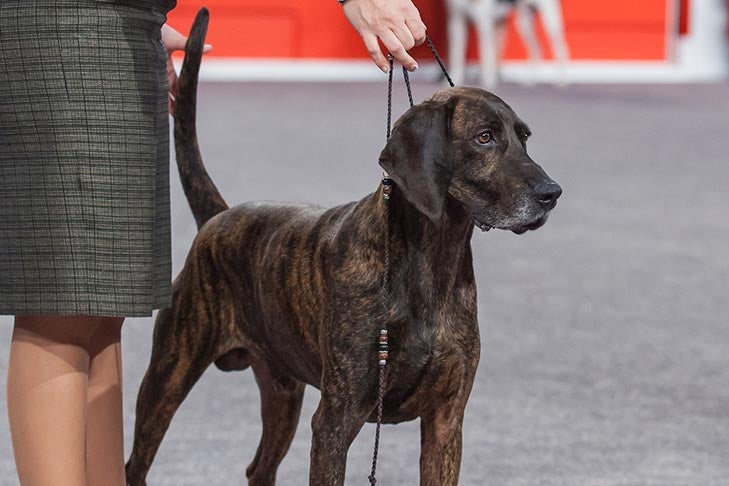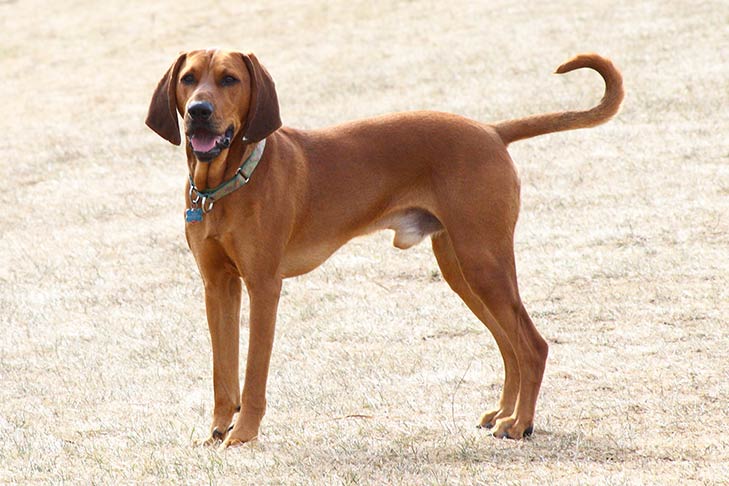- black and tan coonhound
- redbone coonhound
- American English Coonhound
- treeing walker coonhound
- plott hound
Six breeds, the American English Coonhound, Black and Tan Coonhound, Bluetick Coonhound, Plott Hound, Redbone Coonhound, and the Treeing Walker Coonhound, pursue prey through moonlit woods and drive them up a tree. At home, the friendly, easygoing coonhounds like nothing better than laying around the house and getting some quality snuggle time alongside their owners.
Except for the Plott Hound, these American dogs trace their lineage back to British breeds brought to the American colonies in the 17th and 18th-centuries.
The scent-obsessed coonhounds trail raccoons and larger animals until the prey scales leafy tree branches to escape. Trained not to attack, the hounds press their front legs onto the tree trunk and sound out distinctive baying and howling until the hunter arrives. Comfortable around other dogs, these intelligent breeds sport short, smooth coats of distinctive colors and patterns that shed to some degree. Their medium-long, floppy ears sweep the ground for scent, leading the coonhounds toward their prey.
The American Kennel Club recognizes six Coonhounds as part of the Hound Group. The medium-to-large-sized breeds share the same job description and compete in AKC Raccoon Hound Events. With subtle differences in their heads and coat colors, which breed do you want alongside you on a trail or the couch?
American English Coonhound

Descended from English Foxhounds brought to America in the early 1800s, the American English Coonhound crossed with other breeds. The breed was once known as the English Fox and Coonhound and pursued foxes and raccoons. With its sleek, racy, and muscular body, the American English Coonhound’s speed and endurance in pursuit of ring-tailed creatures prove a popular hunting and tagging companion. On a chase, the breed’s deep chest and powerful lungs help sound out a loud bark that the hunter can hear miles away.
The breed’s hallmark is its ticking coat pattern in red and white, blue and white, or tricolored. The American English Coonhound stands 24 to 26 inches at the shoulder for males and 23 to 25 inches for females. Both weigh 45 to 65 pounds.
Affectionate with their family, this sweet-faced worker is content to relax at home but ready to chase any small animals crossing the path. The AKC recognized the American English Coonhound in 2011.
Black and Tan Coonhound

The Black and Tan Coonhound, as its name describes it, has a distinctive coal-black coat with tan accents and distinctive “pumpkin seeds” above its expressive eyes. The largest and strongest of the coonhounds, Black and Tan males stand 27 inches at the shoulder and females 23 to 25 inches. Both sexes weigh 65 to 110 pounds.
This attractive and formidable coonhound descended from the Talbot Hound in England in the 11th century. In America, at the turn of the century, these hounds sniffed out the fox while hunting for Southern landowners.
Later, they crossed with Bloodhounds for their superior scenting ability, tenacity to locate possums and raccoons, and color. A sweet disposition at home, this breed appreciates mental and physical exercise to remain happy. In 1945, the Black and Tan Coonhound was the first coonhound breed registered by the AKC.
Bluetick Coonhound

The Bluetick Coonhound is intelligent and versatile and known for its mottled, or ticked black-and-blue, glossy coat. When picking up the scent of a raccoon, Blueticks can be selective, with some preferring to track the animal and others choosing to chase it up a tree.
This colorful, sensitive breed wants to please its owner and stands out as a loyal companion. Blueticks enjoy performance sports and, with positive training, will engage in obedience, agility, AKC Rally, and Fast CAT.
The sports mascot of the University of Tennessee since 1953, the Bluetick descends from French staghounds gifted to George Washington from the Marquis de Lafayette. Crossed with English Foxhounds and other hound breeds, produced Blueticks bent on following day-old scent trails. Their courage and tenacity caught the attention of author Fred Gibson, who included Blueticks in his book “Old Yeller.” The AKC recognized the Bluetick Coonhound in 2009.
Plott Hound

The Plott Hound is North Carolina’s state dog, and rightly so. In 1750, Johannes Plott arrived in New Bern, North Carolina, with his five German Hanover hounds. The Plott’s ancestor, the Hanoverian Schweisshund (Bloodhound), possessed the uncanny scenting ability to locate a wounded animal on a week-old or longer trail. In the early 1800s, his son, Henry, bred the dogs into lighter, faster hounds and produced today’s Plott.
What sets the Plott apart from the rest of the coonhounds’ soft expressions is this breed’s confident, determined look. They’re ready to take on predators, including bears, mountain lions, and wild boar. Unlike the other coonhounds, the Plott’s coat lacks ticking. The breed’s dark, flashy coat consists of brindle-stripe patterns, from black flecked with gold to flaming orange and russet to solid colors. The AKC recognized the Plott Hound in 2006.
Redbone Coonhound

A medium build, pleading eyes, a sweet voice, and a rich, deep mahogany coat distinguish the Redbone Coonhound from other coonhounds. The breed descends from red Foxhounds brought to America by Scottish immigrants in the late 1700s and Red Irish Foxhounds imported before the Civil War.
Fast, agile, and tenacious, this coonhound is adept at traversing lowlands to steep, rocky hills. The Redbone serves as a faithful companion in the field to hunt raccoons and can pick up a trail that may be weeks old. Wilson Rawls’ autobiographical book “Where the Red Fern Grows” is about a boy who buys and trains two Redbone Coonhounds for hunting. Although a classic children’s novel, the story about the dogs’ loyalty to the boy and tenacity for hunting life in the Ozark Mountains rings true about the breed. The AKC recognized the Redbone Coonhound in 2009.
Treeing Walker Coonhound

Despite its name, the Treeing Walker Coonhound is a fast runner with long, muscular legs and a streamlined frame that covers distance quickly with minimum effort. “Treeing” refers to the breed’s ability to trail a raccoon’s scent until it dashes up a tree. The sweet-faced hound camps at the base and first sounds a bay followed by a distinctive “chopping bark” sound until the hunter arrives.
“Walker” comes from Thomas Walker of Virginia, who helped develop the breed in the mid-1700s from English and American Foxhounds. The Treeing Walker Coonhound has distinctive tricolored white with black and tan markings or is bi-colored with black and white or tan and white. With a soft expression, this breed is affectionate to its family and is amiable with other dogs. The AKC recognized the Treeing Walker Coonhound as a breed in 2012.

